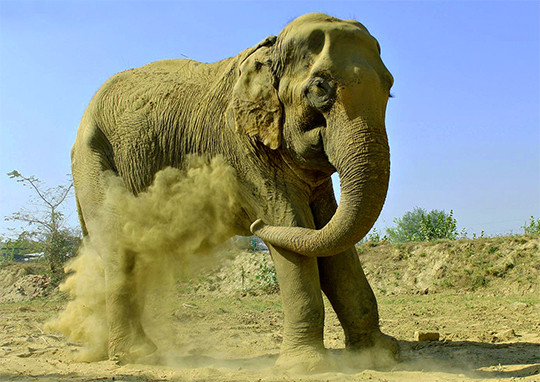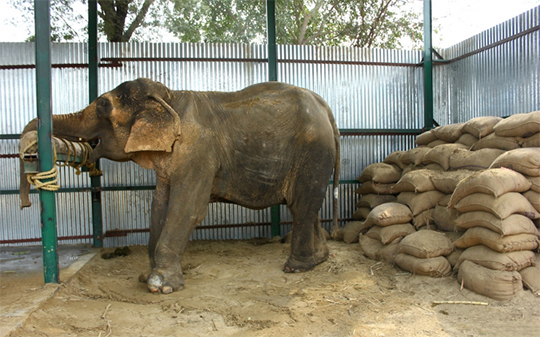Ban Cruel Traveling Animal Performances in the USA! Elephants, tigers, camels, lions, monkeys and so many others are denied their natural instincts and behaviors in circuses. Packed into trucks and trailers, more suffering awaits them at every destination. These animals need your urgent support now for a bill in the House of Representatives that - if passed - would ban the use of wild animals in U.S. circuses and traveling performances. Let's end this! TAKE ACTION
Mohan, Raju, and Sanjay have something tragic in common: they were all illegally owned and abused before you helped us rescue them. While the battle to save other elephants like them remains ongoing, today we can announce some very good news from the front: Wildlife SOS (WSOS) is working with the Uttar Pradesh Forest Department (UPFD) and Chief Wildlife Warden Umendra Sharma on a first-of-its-kind public-involvement campaign to stop illegal elephant trafficking in the state — for good.
Raju: a victim of elephant trafficking

Illegal trafficking of elephants involves making false "ownership" claims of elephants, then illicitly selling them off to the highest bidder. Trafficked elephants often end up living lives of hard labor, physical punishment, and psychological abuse in circuses, temples, and begging for pocket change for their “owners” on noisy city streets. Our first collaborative step involved working with Sharma to create a series of newspaper advertisements with reward incentives encouraging citizens to report any suspicious activity. We set up two hotline numbers for informants to call with any information. Responsible citizens can also use the hotlines to send geo-tagged photographs via WhatsApp, specific GPS coordinates via SMS text, and so on. All information will be turned over to the UPFD to be cross-checked with their own database — and swift action against offenders can then commence. WSOS guarantees complete anonymity for all whistle-blowers reporting criminal activity.
Mohan: a victim of elephant trafficking

Tell the L.A. Zoo it is Time to Retire Billy the Lonely Elephant to a Sanctuary!Billy the elephant has spent the past thirty years living in isolation at the Los Angeles Zoo. The elderly elephant exhibits many signs of zoochosis, a serious psychological disorder commonly found in captive wild animals. According to a petition on Care2, Billy has been seen swaying, rocking side to side, and bobbing his head compulsively for years. Witnesses describe him as appearing incredibly stressed and depressed.
The petition states public protests and a lawsuit have forced the zoo to create a new facility for Billy. However, witnesses say Billy is still being kept in a tiny enclosure on the new facilities, and he doesn’t seem to be doing well. Elephants are highly social creatures with deep-rooted family bonds. Keeping Billy in isolation away from other elephants is nothing but cruel. Additionally, Billy does not get the appropriate daily exercise elephants need to maintain good health.
Many people have been fighting to release Billy from his dismal fate, including celebrities Bob Barker, Cher, and Lily Tomlin, who donated $1.5 million to relocate him. However, the L.A. Zoo still refuses to let the elephant go.
Currently there are two elephant sanctuaries in the United States – PAWS ARK 2000 in Northern California and The Elephant Sanctuary in Tennessee. If you want to see beautiful Billy living the remainder of his life freely at one of these sanctuaries, please take a moment to sign this petition demanding he be relocated. And please remember to share with friends and remind them to not support zoos or other tourist attractions that neglect animals and exploit them for profit.
Baby Elephants Abused at German Zoo. Elephant expert Carol Buckley, who evaluated the footage, explained that the sole purpose of this systematic abuse – whereby trainers inflict pain on adult and baby elephants for even the slightest perceived transgression – is to teach them tricks and that it can lead to long-lasting trauma.
PETA Germany has filed a complaint with local law enforcement and is calling for the facility’s elephant exhibit and breeding programme to be closed. You can help put an end to cruelty like this by refusing to visit any zoo, circus, or other attraction that holds elephants captive for human entertainment.
| Shrine Circuses Work With Animal Abusers |
| ||
One of the activists responsible for stopping the shipment of this baby elephant is a Buddhist monk named Omalpe Sobitha. The Gulf Times credits Sobitha with saying, “Sri Lankan elephants have very strong family ties and to take away a child is a sin.” Additionally, he explained how the change in climate would also be a great shock to the young calf. (Mean temperatures in Sri Lanka are around 27 degrees Celsius compared to 15 degrees in New Zealand.)
Thankfully, the outcries from these concerned activists had an impact on the ruling court. This baby animal, named Nandi, will get to keep living with her family of ninety-three elephants in their sanctuary home – at least for now, until the court case is officially closed.
We hope this victory for elephants is an indication to the end of Sri Lanka’s practice of gifting captive wild animals. World leaders must take a stand and acknowledge that this habit is harmful to wildlife, and they ought to refuse any offers of animals as gifts. If you are as happy as we are about this success story for animal rights, please share it with your friends and remember all animals are individuals, not objects to be given as gifts.
WE DEMAND RESCUE FOR GAJRAJ AT SATARA TEMPLE, KERALA: 50 years of captivity, 4 legs chained, sores! ENOUGH!
Last, we are deeply saddened to announce her passing. Sita came to us as one of the most abused elephants we've seen, and though her departure breaks our hearts, she leaves behind memories of remarkable kindness and endurance.
Rest in peace, Sita

Sita had a badly fused limb from a broken leg that was never allowed to heal. She had a painful case of ankylosis in both front legs, and abscesses riddled her feet and toenails. Sita had been forced to work despite her old age and debility, even as her kidneys and liver grew steadily weaker from age and malnutrition. She was possibly the worst case of neglect we’d ever seen in a circus elephant — or in any other elephant, for that matter. When you work with captive elephants, you see a lot of pain and suffering, but you’re also blessed with the chance to experience the immense capacity to forgive and the enviable resilience that is so special to some elephants — and this past 18 months with Sita has been testament to why elephants don’t ever, ever belong in captivity; why making them perform or beg or entertain for our amusement is an insult to their sentience and their capacity to feel, love, and trust, and to the amazing intelligence that allows them to comprehend the betrayal of this love and trust — and somehow move on. Sita did not deserve the life she had. No elephant does.
We did everything we could to make Sita comfortable, to help her heal at her own pace: footbaths, a nutritious healthy diet, short leisurely walks whenever she felt up to it, baths, painkillers. With supporter donations, we bought her a crane for the nights she would slip, fall, and struggle to get back to her feet. Our veterinary team were angels, steeling themselves against the pain of knowing better than everyone else what she was going through, and remaining determined to make her better despite fully understanding the challenge of it. Her keepers were her guardians, by her side for every painful step, their hands running reassuringly along her trunk through every treatment. Gradually, this battered and withdrawn elephant began showing us glimpses of her personality as she slowly began trusting us.
But she was still more reserved than her best friends Mia and Rhea. Even the day she reunited with Rhea, the third "sister" elephant from their circus we rescued six months later, Sita’s welcome to her long-lost friend was serene. She rumbled softly, linked trunks with her sisters, then caressed and comforted them both in a private oasis of peace that she created for them. Sita was a gentle soul.
And Sita was aware of her strength, firmly but gently moving vets away if a treatment bothered her, careful never to hurt anyone. But more than her physical strength, it was her resilience, her mental strength, and her calm fighting spirit that inspired us. Sita fought every day of her life — to walk, to move, to get a bit of rest, simply to live. Fate had dealt her the cruellest of cards for nearly her entire life, but she was determined to make the best of the time she had while with us.
By the end, there was not one visitor, one keeper, one staff member, one volunteer to the Elephant Conservation and Care Center who was not both moved by her plight and awestruck by her determination to fight her circumstances.
During her last few months with us, Sita spent her time in a specially designed enclosure — with its soft, gunny sack slope for sleeping and support pole for leaning against. We brought in freshly ploughed mud, gentle on her worn-out feet. And she loved her new room, finally at ease, finally getting some restful nights.
Sita's room

Her elephant sisters Mia and Rhea said their goodbyes this morning in a quiet and somber manner, quite unlike their usual boisterous selves. Sita would have appreciated that. Our staff said goodbye the same way.
Her time with us was brief, too brief. For her more than 60 years of captivity and cruelty, she had just a year and a half with us. It pains us to know we didn’t have more time to undo all those years of neglect, to make right the wrongs done to her at human hands, to give her a real chance at a healthy life, the life of a free elephant. But we hope we were the calm in her stormy life, just like the moment on the night of her rescue, that briefest of dry spells in a torrential downpour. We want to believe that Sita had a taste of respite — of kindness, of healing, of trust, and of so much love — through her time with us, and that wherever she is now, the clouds beneath her are white and soft and gentle on her tired feet.
Sleep well, Sita, and know that there will always be a special place in all our hearts for you — a place cushioned with gunny sacks and support poles and freshly ploughed soil and full of love and rememberance. We miss you.











